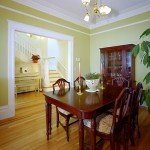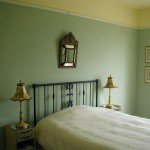Interior Painting FAQ
1) Do you charge for estimates?
We never charge a fee to provide an estimate for your painting project.
2) How do I get an estimate?
You may either contact us or use our request an estimate link by clicking HERE.
3) Do you have references?
Yes, our references our available upon request.
4) Does someone have to remain home while the painting is being done?
No, in fact most people are not home during the day and arrangements can be made in advance to accommodate your schedule. Our employees are, insured and screened with criminal background checks- so you can feel confident. Also, we (the owners) will be on the job at all times that will communicate with you and our staff regularly throughout the project
5) What do I have to do in order to get ready for the painters
When we come to paint your home, we are expecting to handle everything ourselves. We move all of the furniture into the middle of the room, remove pictures from the walls and take down any window treatments. All furniture and belongings are carefully covered and all floors are protected with the proper drop cloths during painting. The only items we ask the customer to move are the small type items. Upon completion of the painting we will place all furniture back in the location that it was removed from and re-hang pictures and window treatments.
6) How often should you have to paint the interior?
Many factors can contribute to that.
- The quality of the paint used is of the utmost importance.
- The amount of traffic through a particular area.
- Whether or not there are smokers in the home.
- Is there a fireplace that is used on a regular basis during the winter months, and does the damper work properly?
- How many children and their ages?
- There are too many factors to take into consideration, and each home can be different. However a good quality job done by a professional crew should last anywhere from 6-10 years. Call us and we will be happy to evaluate your particular situation and offer you a more precise answer.
7) How is my furniture protected during painting?
After moving the furniture into the middle of the room it will be covered in plastic. All floors will be protected by canvas drop cloths.
8) What kind of surface preparation is done?
All holes are filled and sanded. All cracks are properly scraped out, filled and sanded. Caulking is inspected around all windows and frames, doors and door frames and re-caulked as needed. Crown molding, chair rail etc. are all caulked and properly prepared. All nail pops are repaired and sanded. Any water stains, crayon marks etc. are sealed before painting and grease and heavy dirt accumulations are cleaned. Any mildew that is present will be cleaned prior to painting.
9) How many painters will be in my home?
While every job is different normally you can expect a crew of 2-3 painters.
10) What kind of paint is used?
We only use top of the line paints and primers for our customers. Sherwin Williams and Benjamin Moore are the preferred brands. As to the type of paint being, oil based or latex, homes and requirements are different. We would have to evaluate your home and see what your particular needs are and we are certainly willing to meet your desires.
11) What is the difference between a flat, high gloss, satin, and eggshell finish?
These terms indicate the sheen or gloss level, or degree or light reflectance, of the paint. Basically, these are terms that are used to describe paint’s shininess.
- High Gloss Finish
Where to Use: Kitchen and bathroom walls, kitchen cabinets, banisters and railings, trim, furniture, door jambs and window sills
Comments: More durable, stain-resistant and easier to wash. However, the higher the gloss, the more likely surface imperfections will be noticed.
- Semi-gloss
Where to use: Kitchen and bathroom walls, hallways, children’s rooms, playrooms, doors, woodwork and trim. Comments: More stain-resistant and easier to clean than flat paints. Better than flat for high-traffic areas but again keep in mind that a higher gloss shows more of the surfaces imperfections.
- Satin or Silk
(Range overlapping eggshell and semi-gloss)
Where to use: Similar characteristics to semi-gloss and eggshell.
Comments: Similar characteristics to semi-gloss and eggshell.
- Eggshell.
Where to use: Can be used in place of flat paints on wall surfaces especially in halls, bathrooms and playrooms. Can be used in place of semi-gloss paints on trim for a less shiny appearance.
Comments: It resists stains better than flat paint and gives a more lustrous appearance. Due to its low sheen surface imperfections are also less noticeable.
- Flat
What to use: For general use on walls and ceilings. Hides surface imperfections.
Comments: Stain removal can be difficult. Use for uniform, non-reflecting appearance. Best suited for low-traffic areas.
- Matte Same characteristics as flat.
12) How long will it take for the paint to dry?
Acrylic (latex) paint dries much faster than Alkyd (oil). Usually a couple of hours is plenty of time. Oil paint though should dry overnight. Flat paint may dry faster than semi gloss.
13) I have oil based paint on my trim; can I switch to acrylic latex enamel?
Yes. However there are necessary steps that must be taken first in order to assure success. Only use a contractor who is knowledgeable about those steps and one who is willing to explain the proper procedures to you.
14) I have received a number of estimates from different painting contractors and there seems to be a wide variance in prices, why is that?
There are a number of good painting contractors to choose from and what you will normally find is that the established companies are usually fairly close in price. However at times you will get an estimate that is a lot lower than others and at times you may get one that seems excessively high. There could be many factors here. Is the company licensed and insured? Do the painters work for the company therefore being subject to all of the additional payroll expenses? or are they daily labor?
15) Which is better for repainting interior walls, latex or alkyd based paint?
For most applications on interior walls, a latex paint will offer many advantages over alkyd paint. In most available products you will receive better color retention and the finish will be non-yellowing. Additionally, the latex products will have a lower odor, dry faster, and you will be able to clean up with soap and water.
16) We have drywall damage… Do we need to have that repaired before the painters come?
Our employees are all experienced in drywall repair and replacement. Most minor repairs that need to be made can be done as part of the preparation work we do prior to painting.
17) The house doesn’t look that bad. Why should I paint?
A house is a lot like an automobile in the fact that the investment is large and the maintenance is a must. If we don’t wait until the engine blows to check or change the oil we can protect our investment.
18) What happens if I contract with someone who is not properly insured and one of their workers later claims to have gotten hurt while working on my home?
You as the homeowner can be held personally responsible for injuries sustained by an uninsured worker while they are on your property. You can be in a very awkward position with your own insurance company as a result of this type of accident. Most people do not realize this, but it can be verified by a phone call to your attorney or insurance agent. Always ask for verification of insurance if you have any doubt. And remember a company’s general liability insurance is not the same as workers compensation! The best way to be sure is to request a certificate of insurance.
19) Why is painting so expensive?
Painting, like everything else, is expensive. We realize that. In the last 20 years, our labor cost has increased fourfold. The cost of paint has almost doubled. Insurance for a business is astronomical. So you are absolutely right, it is expensive. But not when you look at the cost of painting compared to carpeting, fabric, wallpaper, and window treatments at about $10.00 to $50.00 per square foot compared to painting at about $1.00 to $2.00 per square foot, it doesn’t seem too bad.
20) Do you provide touch up paint after painting is finished?
Yes, in most cases, our house painting company provides customers with the leftover paint for touch ups.





